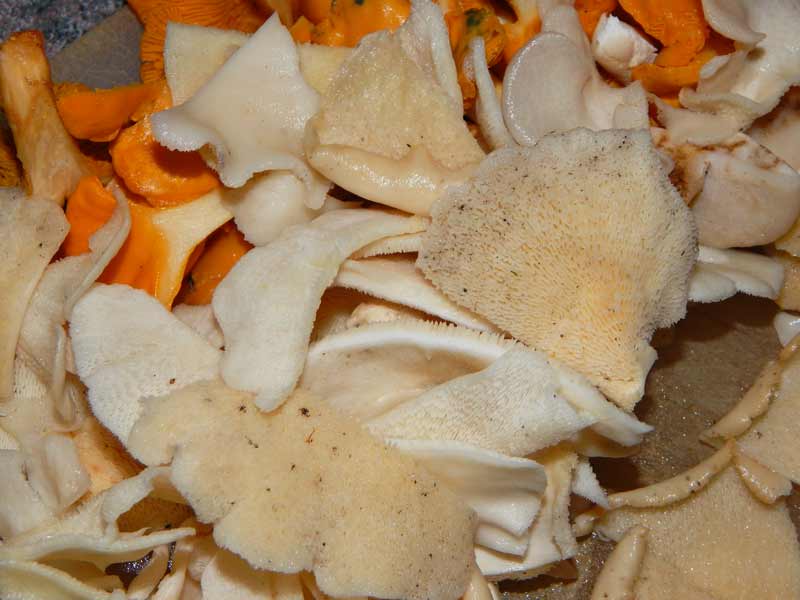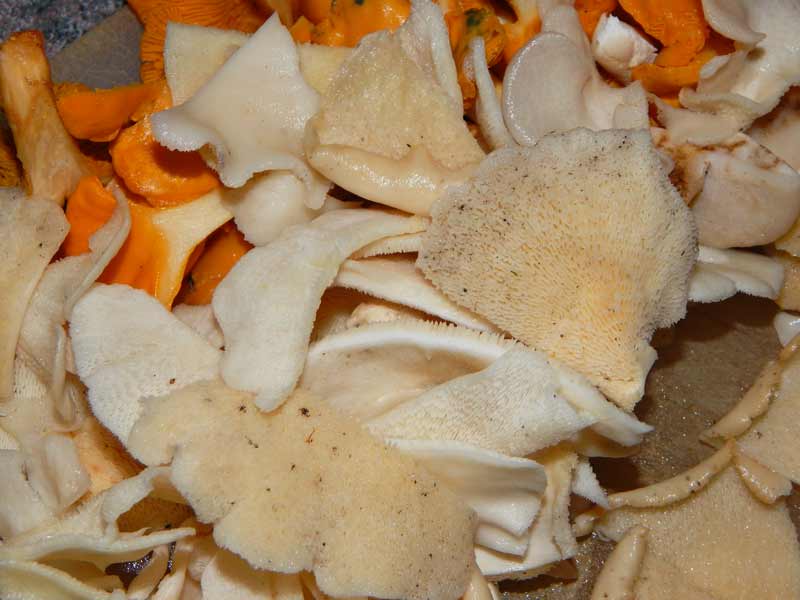I ate some Polyporus tenuiculus a couple of days ago.
No, that’s not some kind of squid, or bug, or horrible fermented thing from some scary country whose restaurants you’re afraid to frequents.
Polyporus tenuiculus is a type of fungus that grows on decaying wood. Here’s a photo:
NOTE: Don’t go eating wild mushrooms unless YOU KNOW WHAT YOU’RE DOING! And don’t blame me if you either:
A: Die
or
B: Spend time on a rocket ship with the ghost of Jerry Garcia visiting the Land Of Magical Unicorns.
That said, back to today’s post.
The mushrooms have been up again in profusion thanks to all of our rain.
At church this week I stepped out the back door and saw the above mushroom growing in rubbery ears all over a stump… so I harvested a goodly amount of them to bring home.
At first glance I thought they a flush of oyster mushrooms but then realized the gills were all wrong, since they were pores rather than actual gills. After some mushroom ID work, I narrowed it down to the Polyporus genus, then finally down to Polyporus tenuiculus.
Hat tip to Greene Deane for the final “yes, that’s it!” piece of my quest for fungal knowledge. Unfortunately, I don’t have photos of them growing on the log since I was camera-less at church.
So, here’s the important part: what does Polyporus tenuiculus taste like?
The flavor isn’t bad, but the texture leaves a lot to be desired. Sauteed they were rubbery and the centers of the mushrooms were really too tough to eat. My bet is that these would be better in soup than fried in butter.
By the way, the bright orange patches in the photo are chanterelle mushrooms, which have returned in our local neighborhood patch of these delicious wild gourmet mushrooms.
Once you really nail down how to avoid poisonous mushrooms, it’s pretty safe to go hunting for good wild fare for the table. I still don’t mess around with gilled mushrooms except for the easy-to-ID Lactarius indigo, also known as indigo milk cap. That edible mushroom can’t be mistaken for anything poisonous, unless perhaps you’re colorblind!
This weekend I’ll be working on editing a couple of little mushroom videos I just recorded on some of the boletes, puffballs, chanterelles and other fungi I gathered (and consumed) this week. This rain has been marvelous for bringing some variety to our cooking. Those videos should be posted early next week – stay tuned… and have a great weekend!



8 comments
I ate some today: put them in soup as you suggested, but didn’t cook long enough. They were tasty but chewy. Thanks!
Good work! They’re always been pretty chewy for me, too.
I found some today, but they wee aged. will they grow back again soon or have to wait until next year??
They should show up more as the weather cools.
I found some yesterday on a rotten log here in SE GA. I, too, thought they were oysters at first but was wary of the netted structure of the pores. I asked our local mushroom guru, Swampeyappleseed, for verification. He set me straight but said they were considered inedible. I read that they are consumed in South America but, given y’all’s comments, I think I’ll pass. Maybe I’ll find some real oysters next time!
Yes, they’re not very good. At least they’re doing good work turning fallen wood into soil. Thanks for stopping by.
Found some here in Summerville SC. Like everyone else I thought they were oyster mushrooms. I’m not entirely familiar with varieties of edibles here yet. I’m originally from Illinois and know the mushrooms there. Since they’re edible I’m going to try them.
You may wish to look up “How to dry saute mushrooms” This is a helpful way to change the texture from rubbery to more palatable. Often used for Chatarelles, it is useful for other species also.
Comments are closed.